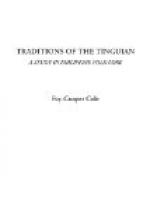The myths of the first division make it plain that, to the people of those times, the sun, moon, and stars were animate—either spirits or human beings. In some cases a similar conception was held for thunder and lightning, while in others they appear as animals. It will appear that such ideas are not foreign to the second division of the tales, which represent present day beliefs. Thus, in the mountain village of Baay the sky is considered as a male spirit—the husband of the earth, and father of sun and moon. Again, in Lagangilang and Abang, the thunderbolt is identified as Kadaklan—the most powerful of all spirits—who “often eats the ground and releases his wife Agemem.”
This brings us to a most interesting question, namely: Are the chief actors in our tales to be considered as celestial beings and spirits, or as human heroes? We have already made note of the fact that in the first tale Aponitolau is identified with Ini-init whom, we are told, was “the sun,” “the man who makes the sun,” “a round stone which rolls.” In this tale he marries Aponibolinayen, a maiden whose name may possibly be construed to mean “the woman in the moon.” [61] However, we find Aponitolau abandoning his place in the sky and going to reside in Kadalayapan. This tale comes from the town of Langangilang where, as we have already seen, the celestial beings are regarded as spirits. Tale fifteen, coming from the same town, shows us this same Aponitolau going up to the sky, where he marries the spirit Kabkabaga-an, but as before he returns to his home below. A further indication of his celestial character is perhaps afforded us in tale fourteen, which was recorded in Patok, a valley town in which the sun, moon, and stars are now regarded as “lights” belonging to the spirit Kadaklan. Here we find that Aponitolau marries the star maid Gaygayoma, who is the daughter of the big star Bagbagak, and Sinag—the moon. In this same tale Aponibolinayen appears as the first wife of Aponitolau, and it is clear that in the mind of the story teller she is not identified with Sinag. Aponitolau appears in the other tales without any hint of celestial qualities. Aside from her name and the fact that she is once pictured as visiting the sky, there is nothing to indicate that his wife Aponibolinayen is to be considered as the moon. A careful study of the other characters who reside in Kadalayapan and Kaodanan fails to yield any evidence that they are considered as celestial beings.
During the Sayang ceremony held in San Juan, a certain man and woman, who are then called Iwaginan and Gimbagon [62], represent the good spirits and are defended by the people when evil spirits try to dispossess them of their property. This is the only instance I have observed in which the names of any of these characters of the tales appear in the ceremonies, while a list of more than one hundred and fifty spirits known to the Tinguian fails to reveal more.




